
Desertification is a type of gradual land degradation of fertile land into arid desert due to a combination of natural processes and human activities. This spread of arid areas is caused by a variety of factors, such as overexploitation of soil as a result of human activity and the effects of climate change. Geographic areas most affected are located in Africa, Asia and parts of South America. Drylands occupy approximately 40–41% of Earth's land area and are home to more than 2 billion people. Effects of desertification include sand and dust storms, food insecurity, and poverty.
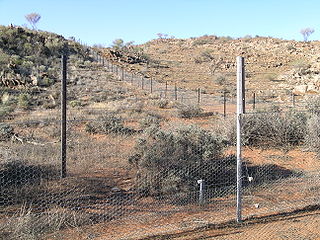
Overgrazing occurs when plants are exposed to intensive grazing for extended periods of time, or without sufficient recovery periods. It can be caused by either livestock in poorly managed agricultural applications, game reserves, or nature reserves. It can also be caused by immobile, travel restricted populations of native or non-native wild animals.

A grassland is an area where the vegetation is dominated by grasses (Poaceae). However, sedge (Cyperaceae) and rush (Juncaceae) can also be found along with variable proportions of legumes, like clover, and other herbs. Grasslands occur naturally on all continents except Antarctica and are found in most ecoregions of the Earth. Furthermore, grasslands are one of the largest biomes on Earth and dominate the landscape worldwide. There are different types of grasslands: natural grasslands, semi-natural grasslands, and agricultural grasslands. They cover 31–69% of the Earth's land area.

A savanna or savannah is a mixed woodland-grassland ecosystem characterised by the trees being sufficiently widely spaced so that the canopy does not close. The open canopy allows sufficient light to reach the ground to support an unbroken herbaceous layer consisting primarily of grasses. According to Britannica, there exists four savanna forms; savanna woodland where trees and shrubs form a light canopy, tree savanna with scattered trees and shrubs, shrub savanna with distributed shrubs, and grass savanna where trees and shrubs are mostly nonexistent.
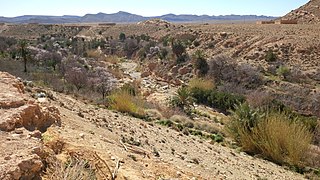
Deserts and xeric shrublands are a biome defined by the World Wide Fund for Nature. Deserts and xeric shrublands form the largest terrestrial biome, covering 19% of Earth's land surface area. Ecoregions in this habitat type vary greatly in the amount of annual rainfall they receive, usually less than 250 millimetres (10 in) annually except in the margins. Generally evaporation exceeds rainfall in these ecoregions. Temperature variability is also diverse in these lands. Many deserts, such as the Sahara, are hot year-round, but others, such as East Asia's Gobi, become quite cold during the winter.

A meadow is an open habitat or field, vegetated by grasses, herbs, and other non-woody plants. Trees or shrubs may sparsely populate meadows, as long as these areas maintain an open character. Meadows can occur naturally under favourable conditions, but are often artificially created from cleared shrub or woodland for the production of hay, fodder, or livestock. Meadow habitats, as a group, are characterized as "semi-natural grasslands", meaning that they are largely composed of species native to the region, with only limited human intervention.

Bromus tectorum, known as downy brome, drooping brome or cheatgrass, is a winter annual grass native to Europe, southwestern Asia, and northern Africa, but has become invasive in many other areas. It now is present in most of Europe, southern Russia, Japan, South Africa, Australia, New Zealand, Iceland, Greenland, North America and western Central Asia. In the eastern US B. tectorum is common along roadsides and as a crop weed, but usually does not dominate an ecosystem. It has become a dominant species in the Intermountain West and parts of Canada, and displays especially invasive behavior in the sagebrush steppe ecosystems where it has been listed as noxious weed. B. tectorum often enters the site in an area that has been disturbed, and then quickly expands into the surrounding area through its rapid growth and prolific seed production.

In agriculture, grazing is a method of animal husbandry whereby domestic livestock are allowed outdoors to free range and consume wild vegetations in order to convert the otherwise indigestible cellulose within grass and other forages into meat, milk, wool and other animal products, often on land that is unsuitable for arable farming.

Agropyron cristatum, the crested wheat grass, crested wheatgrass, fairway crested wheat grass, is a species in the family Poaceae. This plant is often used as forage and erosion control. It is well known as a widespread introduced species on the prairies of the United States and Canada.

Clifford Allan Redin Savory is a Zimbabwean livestock farmer and president and co-founder of the Savory Institute. He originated holistic management, a systems thinking approach to managing resources.
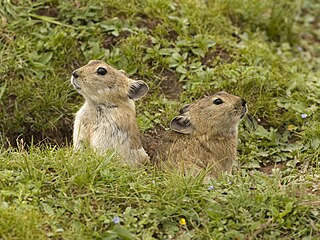
The plateau pika, also known as the black-lipped pika, is a species of mammal in the pika family, Ochotonidae.

Conservation grazing or targeted grazing is the use of semi-feral or domesticated grazing livestock to maintain and increase the biodiversity of natural or semi-natural grasslands, heathlands, wood pasture, wetlands and many other habitats. Conservation grazing is generally less intensive than practices such as prescribed burning, but still needs to be managed to ensure that overgrazing does not occur. The practice has proven to be beneficial in moderation in restoring and maintaining grassland and heathland ecosystems. Conservation or monitored grazing has been implemented into regenerative agriculture programs to restore soil and overall ecosystem health of current working landscapes. The optimal level of grazing and grazing animal will depend on the goal of conservation. Different levels of grazing, alongside other conservation practices, can be used to induce desired results.
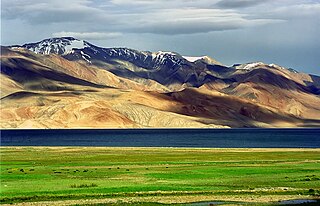
The Alpine-steppe is a high altitude natural alpine grassland, which is a part of the Montane grasslands and shrublands biome.

The land imprinter is a no-till device for establishing grass cover in arid environments and deserts. The imprinter consists of a metal roller, with steel angles welded to the surface in various configurations. The angled teeth of the imprinter cut through weeds and brush to form a mulch, while the teeth press seeds of grasses and other plants into the soil. The imprints remain stable for approximately two years. During that time, imprints funnel water toward seedlings, protect them from wind, and concentrate nutrients for plant growth.

Holistic Management in agriculture is an approach to managing resources that was originally developed by Allan Savory for grazing management., Holistic Management has been likened to "a permaculture approach to rangeland management". Holistic Management is a registered trademark of Holistic Management International. It has faced criticism from many researchers who argue it is unable to provide the benefits claimed.

The Mu Us Desert, also known as the Maowusu Desert, is a desert in the northern Ordos Plateau in Inner Mongolia, Northwest China. Its southeastern end is crossed by the Ming Great Wall, and it forms the southern portion of the Ordos Desert. The Wuding River drains the area, and then flows into the Ordos Loop of the Yellow River.
Grassland accounts for China’s largest land resource, covering nearly 41 percent of the national land area. Grassland in the Chinese context comprises widely varying eco-types ranging from the meadows and forest steppes of former Manchuria in the Northeast; and the high, alpine pastures of the Qinghai-Tibetan plateau; to the (semi)arid steppes and deserts in China’s Great West. Due to this geographical and ecological variety, the utilization of grassland is not limited to grazing and forage production, but extends to the exploitation of grassland and forest by-products, as well as the exploitation of mineral resources. Of the total of around 393 million hectares of grassland in China, 84 percent or 331 million hectares is deemed usable for grazing.
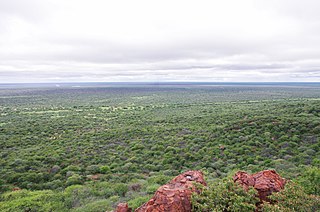
Woody plant encroachment is a natural phenomenon characterised by the increase in density of woody plants, bushes and shrubs, at the expense of the herbaceous layer, grasses and forbs. It predominantly occurs in grasslands, savannas and woodlands and can cause regime shifts from open grasslands and savannas to closed woodlands. The term bush encroachment refers to the expansion of native plants and not the spread of alien invasive species. It is thus defined by plant density, not species. Woody encroachment is often considered interpreted as a symptom of land degradation. The phenomenon is observed across different ecosystems and with different characteristics and intensities globally.
Annual grasslands are a type of grassland ecosystem characterized by the dominance of annual grasses and forbs. They are most commonly found in regions with Mediterranean climates, such as California, and provide important habitats for a variety of wildlife species.

















